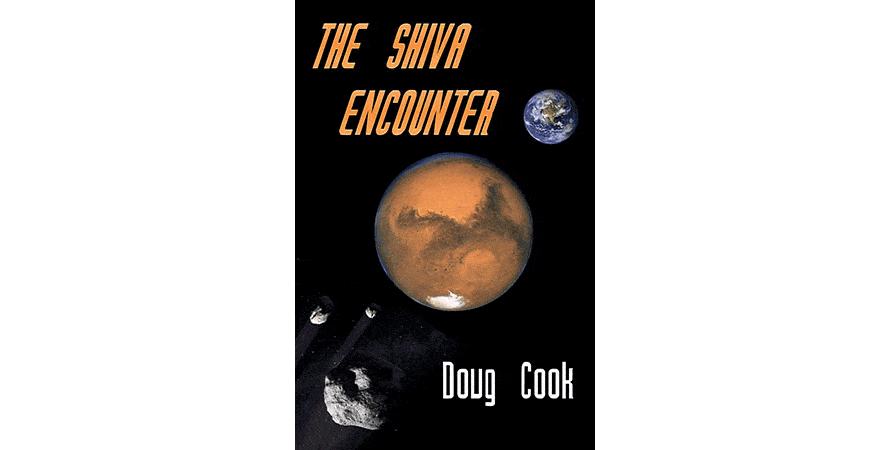Category: Fiction
Reviewed by Peter Spasov
Title: The Shiva Encounter
Author: Doug Cook
NSS Amazon link for this book
Format: Paperback, Kindle
Pages: 395
Publisher: AquilaMission.space
Date: February 2020
Retail Price: $14.95/$3.95
ISBN: 979-8604583951
The Shiva Encounter is a sequel to Cook’s Arcadia Mars and The Aquila Mission. Shiva is a one-hundred kilometer asteroid with a one in fifty probability of striking Earth during the year 2079. The story is about how some Martian colonists intend to save the day. Presumably, a future book will show if humanity succeeded in diverting the asteroid. In addition, there is an extraterrestrial artifact apparently connected to the fate of humanity.
This ‘novel’ has much in common with non-fiction about space settlement. It features an introduction, preface, prologue, and a history until Chapter 1 begins. Dramatis Personae, an appendix, a glossary and some promotional material follow its eight chapters. Then there’s an epilogue. Much of this support material may interest those dedicated to creating a spacefaring civilization.
The introduction explains the asteroid scenario, spaceship technology, Mars settlement, the possibility of extraterrestrial life and other background to review the earlier novels. And the preface gives us the author’s motivation for writing his series.
The chapters often include illustrations with captions such as a NASA photo or a diagram of interplanetary orbits. Cook realistically includes time-delay issues with interplanetary communication, explains the psychological problem of space isolation, describes space-mission emergencies such as a docking-station fault, and includes other information such as resveratrol, a key component of red wine, having potential to combat atrophy in zero or micro gravity conditions.
The plotline includes climate disasters force humanity to establish colonies in space and contains plenty of action. There is sabotage, international strife, space emergencies, interpersonal conflict, births and marriages, extraterrestrial contact, hints of linkages to ancient human history—and a humungous asteroid on its way towards Earth. Cook repeats this line near the start of most chapters: ‘Shiva is coming….’ People debate the pros and cons of striking the asteroid that may or may not strike the Earth. The author thoroughly covers the issue of debris and invents a clever scheme to handle it.
The appendix lays out succinctly the issue of climate change in a way rarely seen. It is a helpful big-picture overview and reminder of the situation often lost in the media covering the issue.
These strengths all serve a commendable educational purpose. The book explains much—but—as a story, it imposes considerable narrative distance between reader and character. To convey a sense of history, many sections and chapters begin with an epigraph by some notable person involved in the history of space exploration, such as Elon Musk. Yet, to immerse the reader more into the author’s future world, Cook could have included a few made-up epigraphs from future fictional personages.
Sometimes, in order to provide relevant background to the reader, a character delivers information that other characters would already know. This makes the dialogue sound contrived. Additionally, there isn’t much to distinguish one character’s voice from another’s. The narrative often repeats a long string of names. It’s a habit that can grate.
With one exception, the protagonists are too flawlessly heroic, and the one exception was awkwardly handled. For instance, a crewmate uses a lecturing tone to handle a panicking astronaut. Cook does tell the reader about stress being a spaceflight issue, albeit in a clinical manner instead of letting the reader experience it as a terrifying emotion.
The book includes a self-aware Artificial Intelligence (AI). One scene has an AI somewhat emotionally reaching out to another AI who is flying to self-destructive doom. Here, Cook missed the opportunity to explore a moral conundrum. What are the ethical obligations (if any) for humans when equipping spacecraft with a conscious AI, only to deliberately smash (her/him?) into an asteroid?
And then there is telepathy, a power a couple of major characters have and also passed on to their offspring. This may strike some readers as pseudo scientific and appears very much out of place in what is otherwise a thoroughly hard science fiction story. This ability is presented as a Deus ex machina, a plot device to solve a seemingly unsolvable problem in a story. In this case, the problem is how to communicate with ‘The Box,’ the extraterrestrial artifact the characters retrieved from a comet. Whereas the author spends considerable time developing other aspects of the setting, for telepathy he says little except that it is somehow genetic.
This is an adventure story involving plausible technology, astronautical facts, and more speculative aspects. For those who thrive in hard scientific possibilities there is much to relish. Undoubtedly Cook has worked out an intriguing set of possibilities. The story-telling style, however, limits how much the reader can connect with the characters and their world. The fiction resembles a case study for strategic planning. Cook has an interesting story although the narration could be more compelling.
© 2020 Peter Spasov
Please use the NSS Amazon Link for all your book and other purchases. It helps NSS and does not cost you a cent! Bookmark this link for ALL your Amazon shopping!



















